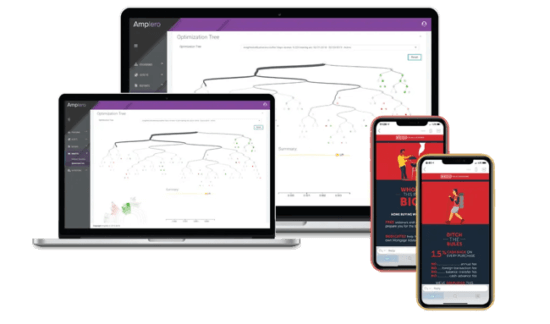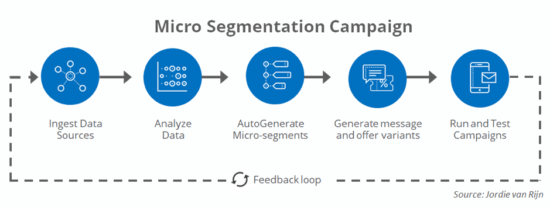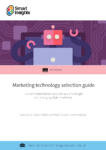There is a big opportunity to gather valuable data, but having data sitting in a database isn’t enough.
The future of customer marketing is data. Brands say they want to “be more data-driven” and level up their marketing. There is a big opportunity to gather valuable data, but having data sitting in a database isn’t enough. Only by refining the process of data activation can brands improve conversions, promote loyalty and increase repeat purchases.
Data activation is a part of our new business reality, and with advances in marketing intelligence and AI, all the steps in what we call the data value chain are built on top of technology.
This means that your Martech stack can push you forward or hold you back.
In a world where your marketing results are directly influenced by the marketing technology you use, you need to choose smart tools. Let’s see how the use of smarter MarTech makes it easier to live up to today's customer expectations.
Think about it.
- Can you easily add product recommendations to your site or email campaigns?
- Can you easily and quickly optimize and A/B test campaigns?
- How about using segmentation or behavioural-based automation?
In my experience with companies, the easier and faster it is to bring data-driven intelligence to the table, the higher the adoption will be in all phases. How you create a marketing campaign is dictated by the possibilities your technology gives.
Take for instance email segmentation. The number of segments a marketer can deploy campaigns to is limited by the tools they use. Each manual step in the process to generate creative for each segment and do A/B multivariate testing limits the number of segments you can manage.
Now if you’d use marketing tools to do tasks for you automatically, it removes those limitations and allows for smaller segments or even “segment of one” marketing.
An example of AI for micro-segmentation
A case study on how AI for micro-segmentation works to drive your goals comes from Amplero and BECU. They desired to improve email responses and drive additional mortgage, credit card and auto loan applications.
With the use of Machine Learning from the tool, micro-segments are automatically generated. Smaller groups of contacts that have similar characteristics. The software then automatically tests different combinations of email subject lines, images, content and offers to determine the best variants (per segment) in order to drive increased applications - the goal of the campaigns.

[Image source: Amplero]
An optimization overview like this is akin to a
decision tree, only showing different segments and smaller segments based on their variables. This campaign showed a 10% lift for credit card, auto loan, and mortgage applications over “business as usual” campaigns. This form of marketing automation shows the capability of automated grouping, matching, recommendations, and testing.

Financial services and banks work in a highly competitive space and have a limited amount of net new prospects. Once you have initial contact, it is definitely worth optimizing financial services email marketing. The very high value per customer and limited variable costs make it especially attractive to put data to work. At the same time, once preferences are recognized - the roll-out is fit for every direct marketing channel.
From signal to sale: Walking down the data value chain
Thinking about data on a strategic level, it helps to visualize the flow of data and identify where the actual value is (or can be) generated. The process of creating value with the aid of data as a connected chain from start to finish. In a practical situation, you’d map each of the stages out and see where you are going to use the data and then work backward. A quick review of the major steps from signal to sale.
1. Gathering data - picking up the data signals
Traditionally the systems where the data resides (like a CRM) is called a “data source”. A ridiculous notion. Take off your IT/technology glasses for a minute - the holistic view recognizes that “where it is stored” is often not “how/where it was gathered”.
We need to recognize that the data points can be sourced from several places, multiple methods and different moments in time.
How you gather data to benefit customers is a crucial part of your business leading up to business value creation.
Although it seems to be the first step, for companies it often isn’t the place to prioritize on their data value journey. There is often plenty of data readily available to be used - like click data from your site and CRM profiles, before coming back to improve and build out data gathering.
2. Bringing together customer data
Your first-party customer data (CRM, website, transactions, profiles) are going to be the most important data streams to feed into your marketing tool.
To bring together customer data you need requires a system that ingests and combines the data and then exposes them for use in further steps. In my opinion, it is not about bringing together as much data as possible and treating that a goal by itself, but rather bringing the data together in a mindful manner. Because in the next step, it is able to turn that ‘practical customer view’ into marketing campaigns that deliver results. Focus on the data you will be using.
It is not strange that the Customer Data Platform (CDP) as a piece of technology is getting a lot of attention. The CDP promises to provide the key to comprehensive data-driven marketing. A very attractive marketing concept where all your customer data is combined for marketing (and other) uses.
Without the data and the management of the data, the ‘marketing brain’ that allows for smarter campaigns simply can’t function and especially within near time/real time if we are acting working with - for instance - site behavior. This brings us to the next stage.

3. Insights and action
Data’s true value is realized when it leads to action. When data helps the customer experience up a leg by in the following stages of decisioning and distribution.
This is the inflection point. It is not enough to “have” the data, your technology should be able to give a better answer to the question what to do with the data. Think about the following themes for action.
- Product and content recommendations, proposing the next best actions.
- Automated testing and optimization.
- Real-time alerting and notifications.
- Customer Insights and analytics.
- Marketing automation and automated follow up campaigns.
- Personalization.
- Lead Scoring and grading.
These are all different uses of data, that lead to a better experience along the customer journey and a more valuable road for each customer.
It works best once you know what you’d like to do. Kelly J. Waffle described a data-driven campaign for a media company that delivered a more than 35% improvement on its return from ad spend compared to historical campaigns by combining the data and improving targeting. With more than 33% of the new ad-generated subscriptions were with millennials and website visitor engagement helped drive digital subscriptions by 4X with behavioral scoring.
This stage of Data Activation is where the rubber meets the road. As I mentioned it is easiest to form a strategy based on a realistic “what we want to do” and work backward from that.
Getting into the data-driven mindset
Companies need to think differently about their data if they want to make the next step. According to the Data-Driven Marketing research by the DDMA, the number one challenge is to realize a data-driven culture, directly followed by the technology, systems, and tools.
The initial wish to “be more data-driven” is there. The access to tools and changing “the way we do things around here” to include more data-driven are two sides of the same coin. We don’t even realize how much technology is influencing the manner day-to-day campaigns are executed.
Data democratization and “Citizen” Martech
The divide between those that are doing a great job in data-driven marketing and those that aren’t might seem unbridgeable. Luckily Marketing Technology is becoming more and more “citizen”, meaning that for those marketers willing to be more data-driven - the technical limitations are fading away and a level playing field is arising. You redefine your company by the MarTech company you keep. So to fill the data-driven ambition, put an emphasis on an overall smarter MarTech stack.










